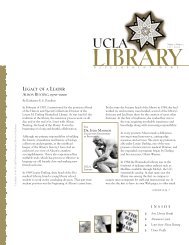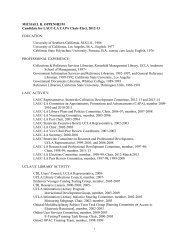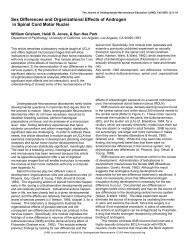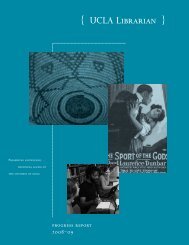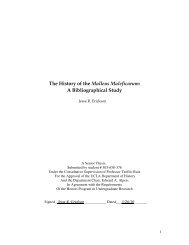Research Paper - UCLA Library
Research Paper - UCLA Library
Research Paper - UCLA Library
Create successful ePaper yourself
Turn your PDF publications into a flip-book with our unique Google optimized e-Paper software.
to medieval ideology that saw “the concept of female inheritance as one of transmission of<br />
Gu 33<br />
power, rather than actual wielding of it” and situates queens (and therefore Elizabeth) as a means<br />
of producing royal progeny (Hopkins 31-2). As much as the Queen tried to escape the role of the<br />
queen as mother by remaining unmarried during her lifetime, she is nevertheless forced into that<br />
role discursively after her death.<br />
While the “prophecies” for Elizabeth were written with the past in mind, the hopes that<br />
James’s “honor and the greatness of his name/ Shall be, and make new nations. He shall<br />
flourish” had not been validated yet at the time of Shakespeare and Fletcher’s collaboration<br />
(V.4.50-54). In fact, James had already disappointed the English people on a few occasions, such<br />
as the selling of hundreds of knighthoods, since his coronation in 1604. The two King’s Men<br />
playwrights produce a fantasy version of Tudor history in Henry VIII, writing out the later half of<br />
Henry VIII’s reign as well as any subsequent conflict in Elizabeth and James’s foreshadowed<br />
reigns.<br />
VII. CONCLUSION<br />
Through an analysis of the negative representations of Elizabeth I in The Revenger’s<br />
Tragedy and Henry VIII, I aim to shed light on early modern views towards female authority as<br />
well as more specific attitudes towards Elizabeth herself in the early 1600s. This thesis attempts<br />
to contribute to further understanding of literary portrayals of queenship and complicate notions<br />
of Elizabeth as the legendary virgin monarch.<br />
Although some critics dismiss Jacobean portrayals of Elizabeth I as veiled critiques of<br />
James I and the prevalence of corruption among his courtiers, an examination of contemporary<br />
historical accounts and iconography about the late queen suggest otherwise. Through elegiac



